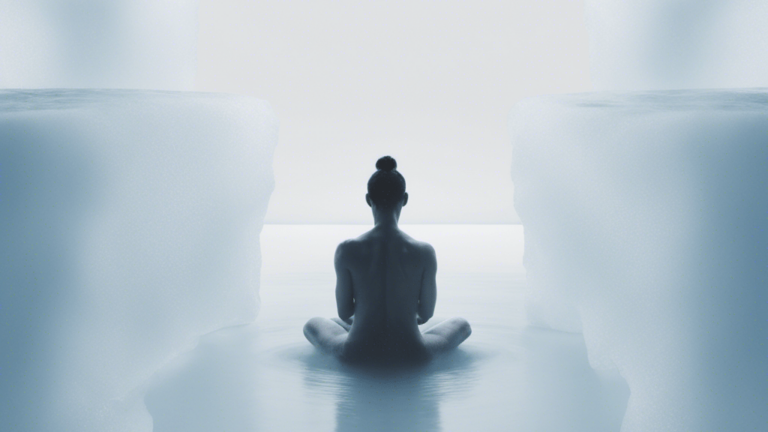How often should you ice bath?

Unveiling the Benefits of Ice Baths
Over the past few years, ice baths have gained massive popularity, especially in the wellness and sports industry. From an unconventional practice for the recovery of athletes, the benefits of ice baths have now become part of the wellness routine of health-conscious individuals.
But what exactly is an ice bath, also known as cold water therapy? As the name suggests, an ice bath involves immersing yourself in icy cold water for a certain period of time. While the idea may seem absurd to many people, ice baths have plenty of scientifically proven health benefits.
The health benefits of ice baths range from recovery after intense workout sessions to psychological benefits. This interesting profile of ice baths attracts many new people to experience them. However, a question that most beginners have on their minds is, “How often should you ice bath?”
Well, now you don’t have to worry about this and many other questions related to ice baths. In this article, we will learn about various scientifically proven benefits of ice baths. Additionally, we will discuss how often you should ice bath and other helpful tips to enhance your cold water immersion experience.
Anatomy of Ice Baths’ Benefits
Accelerating the Recovery Process
One of the most well-known benefits of ice baths is their ability to accelerate the recovery process. This is ideal for athletes and others who engage in intense physical activity sessions.
When you perform intense physical activity, it can lead to muscle soreness and inflammation. Studies show that when you expose your body to the cold water of ice baths, it initially responds by vasoconstriction. In vasoconstriction, there is a reduced blood flow to the muscles, which helps reduce inflammation and swelling.
After about 10 minutes of vasoconstriction, the sympathetic response in your body causes blood vessels to dilate — vasodilation. The dilation of blood vessels assists in flushing out waste products from the muscles, like lactic acid.
The vasoconstriction followed by vasodilation from cold water helps in quicker healing and minimizes the risk of delayed-onset muscle soreness (DOMS). It allows the individuals to get back to training sessions faster with minimum discomfort.
In addition, cold exposure in ice baths stimulates the release of endorphins. Endorphins are natural feel-good hormones that further enhance the recovery experience.

Understanding Ice Baths: More Than Just a Cool Trend
Dissecting the Concept of Ice Baths
At its basic level, an ice bath is just as it sounds: a bath filled with icy cold water. But diving deep into this topic, you will learn that ice baths represent much more than their simple definitions. Formerly known as cold water immersion and ice bath therapy, this practice offers numerous scientifically proven health benefits.
To take an ice bath, you need to immerse yourself in cold water below 15°C (59°F). The duration of the ice baths varies depending on the desired results, but it is often between 10 and 20 minutes.
When the cold water hits your skin, you feel numbness and tingling — pins and needles sensations. After the initial sensations, you feel a boost and alertness, indicating that the ice bath stimulates the nervous system.
Unraveling the Popularity of Ice Baths
Ice baths are equally popular among athletes and wellness enthusiasts for their ability to accelerate recovery, improve energy, and promote mental resilience. Ice baths for athletes are nothing new. Professional sports circles have been using ice baths for ages to assist in muscle recovery and reduce inflammation.
Beyond sports, ice baths have gained significant popularity among health-conscious holistic communities. People find cold water therapy effective in mood regulation, improving sleep quality, and increasing metabolic rate. Because of its benefits, they embrace cold water therapy as a mental, physical, and emotional health booster.
Regular practice of ice baths also promotes mindfulness. When immersed in icy cold water, you need to focus on your breath and body sensations, which stimulate a sense of presence and relaxation.
Clearing Common Misconceptions
Despite their increasing popularity, many misconceptions about ice baths exist. It is crucial to debunk those misconceptions to understand ice baths better.
- While ice baths offer plenty of health benefits, they aren’t a magical treatment for all illnesses. Ice baths can’t replace a balanced diet, regular exercise, or prescribed medical treatments.
- While dunking yourself in extremely cold water may cause hypothermia, it is unlikely to occur when you correctly and safely take an ice bath. Cold water baths are usually of short duration, ranging between 10 and 20 minutes. They should also be supervised, which further reduces the risk of hypothermia.
- Many people believe you need to stay in the ice bath for a very long time to experience any effect, which isn’t true. Ice baths can stimulate their effects — vasoconstriction followed by vasodilation — within 10 minutes.
Overall, it is important to understand the benefits and limitations of ice bath therapy before adding this practice to your wellness routine.

Diving Deeper: The Profound Benefits of Ice Baths
Understanding the Body’s Response to Ice Baths
Immersing yourself in an ice bath is like sending your body into a controlled shock. Your body’s immediate physiological responses are as interesting as they are beneficial.
As the extremely cold water hits your skin, your body quickly moves into survival mode, a phenomenon called cold-induced thermogenesis. This process causes the body to produce more heat by increasing its metabolic rate. Increased metabolic rate is also beneficial as it promotes fat burn.
Another prominent effect of ice baths is reduced inflammation and efficient recovery. The blood vessels contract as you sit in the cold water bath, causing low blood supply to the inflammation area. This process reduces tissue swelling and inflammation and accelerates the recovery process.
Diving into Key Benefits of Ice Baths
Ice baths offer numerous advantages, and knowing about each will help you appreciate the experience better. Here are some key benefits of ice baths:
Enhance Recovery
- One of the earlier known and key benefits of ice baths is enhanced recovery, especially after workouts. When you sit in an ice bath, a set of physiological changes in the body causes improved circulation. The supply of oxygen-rich blood to the muscles promotes faster muscle repair and reduces the recovery time between workout sessions.
- Research shows that cold water immersion after intense physical activity reduces stiffness, fatigue, and muscle damage and improves overall muscle performance.
Boost Immune System
- One of the silent benefits of ice baths is that they boost the immune system. Ice baths improve circulation, facilitating the efficient flow of immune cells — white blood cells — in the body.
Improve Psychological Health
- Many people are unaware that ice baths significantly benefit psychological health. Studies show that cold water immersion triggers the release of neurotransmitters in the brain, such as dopamine and endorphins.
- Dopamine acts as a reward center in the brain, and when it triggers, it gives you a feeling of satisfaction and motivation. Endorphins improve your mood and overall sense of psychological well-being.
Stress Relief
- Besides releasing endorphins, ice baths cause stress relief by making several physiological changes in the body. When you sit in an ice bath, the freezing water triggers a “fight-or-flight” response in the brain.
- This fight-or-flight response helps the body deal with stress efficiently. Regular triggers of this response create mental resilience and improve one’s ability to manage everyday stressors.
Testimonials and Examples Underlining Ice Bath’s Effectiveness
A large number of testimonials, case studies, and endorsements validate the remarkable benefits of ice baths. Many elite athletes, celebrities, and health enthusiasts talk about their effectiveness.
For example, athletes like LeBron James and Tom Brady and celebrities like Tony Robbins use ice baths and endorse their effectiveness.
Scientific studies also provide undeniable proof of the benefits of ice baths. Studies show that ice baths improve post-activity recovery and athletic performance. Studies further show us that ice baths cause a decrease in cortisol levels in the body. Cortisol is a stress marker, and low cortisol levels from ice baths indicate that they reduce stress.
The health benefits of ice baths have significantly contributed to their popularity. These benefits are not just statements but are backed by scientific evidence and expert testimonials, which makes them worth exploring.

Finding Your Chill: How Often Should You Ice Bath?
Addressing the Central Question
“How often should you ice bath?” is among the common questions that beginners ask. There is no one short answer for everyone. The frequency of ice baths depends on your health status, tolerance to cold, and recovery needs.
Some people find ice baths effective when used daily or a few times weekly, while others may not follow a specific routine and use them only occasionally.
Experts recommend that you start slowly with ice baths. You can begin with once a week and gradually increase the frequency depending on how your body responds to them. Everybody responds to cold water therapy or ice baths differently, so you must pay attention to your comfort and overall well-being.
Navigating the Do’s and Don’ts of Ice Baths
Preparing yourself and following guidelines is essential for a safe and effective ice bath experience. Firstly, don’t stay in ice baths for more than 15 to 20 minutes per session. Longer exposure, above 20 minutes, can cause hypothermia. Although the risk of hypothermia is very low in a controlled session, it is wise to be on the safe side.
A basic principle of ice baths is to always listen to your body. Every person has a different tolerance to cold, so it is important to respect your body’s limitations. If you aren’t comfortable with a full-body ice bath, you can start with cold showers or immerse just a portion of your body in an ice bath. You can gradually increase exposure as your body adapts to the cold.
Another important thing is to ensure you are properly hydrated and have eaten a light meal before the ice bath. When you are hydrated properly, your body can regulate temperature efficiently, lowering the risk of hypothermia. Similarly, light meals provide energy to generate heat.
Finally, wear warm clothes after the ice bath session and avoid vigorous activities. This will prevent rapid heat loss from your body. Preparation before ice baths, gradual adaptation, and aftercare make your ice bath experience more enjoyable and effective.
Discussing Sustained Benefits and Potential Downsides
By taking ice baths regularly, you can experience a significant boost in recovery time, immunity, mood, and mental resilience. When you deal with the initial discomfort, dedicated and regular exposure to cold water therapy can boost overall health and well-being in the long term.
However, like any other wellness practice, moderation and balance are key to the effectiveness of ice baths. Going beyond a certain limit will no longer benefit you; it will have negative effects.
If you take ice baths too frequently, they can negatively affect muscle growth and adaptation. Very frequent ice baths are also a risk for people who already have health conditions, such as cardiovascular problems. This is why we recommend that you consult your doctor before stepping into cold water therapy.
In summary, ice baths offer numerous health benefits, from improved muscle recovery to mental resilience. While the frequency of ice baths varies from person to person, you must prioritize your health status, comfort levels, and personal goals.

Wrapping Up the Ice Bath Discussion
Recapping the Cold Facts
In this article on ice baths, we have discussed their core principles and numerous benefits. Most importantly, we talked about how often you should take ice baths.
Ice baths, also known as cold water therapy or cryotherapy, have emerged as an incredible wellness practice in the past few years. Scientific evidence supports their benefits, such as improved muscle recovery, boosted immunity, and stronger mental resilience. We also have testimonials from experts on the benefits of ice baths.
The central question of our discussion, “How often should you ice bath?”, has no direct answer. The frequency of ice baths depends on certain factors, such as your health conditions and ability to tolerate extremely cold temperatures. You must listen to your body for a safe and effective ice bath experience.
Incorporate ice baths gradually into your routine, giving your body the space to adapt over time. Some may find it beneficial to take ice baths several times a week after intense workout sessions. In contrast, others may prefer to take ice baths once in a while to relieve soreness and fatigue.
Remember that ice baths can have adverse effects if you don’t practice them properly. Repeating ice baths too frequently can reduce immune function and increase muscle damage. So, while there is no fixed rule or recommendation on the frequency of ice baths, you should begin slow and listen to your body’s response.
Final Reflections on Ice Bathing and Its Role in Holistic Wellness
Our discussion on the topic of ice baths helped us understand their importance in the wellness routine. With benefits ranging from post-workout recovery to boosted mental resilience, ice baths invite us to leave our comfort zones and immerse ourselves in a stimulating wellness environment.
Even though the idea of facing the cold may seem overwhelming, you must remember that ice baths require balance. They have many benefits, but you can’t consider them a magical treatment for everything. Consider ice baths as a powerful addition to the wellness routine — a routine that ideally includes a balanced diet, regular exercise, and a proactive approach to health. Remember, wellness is a journey, not a destination.







